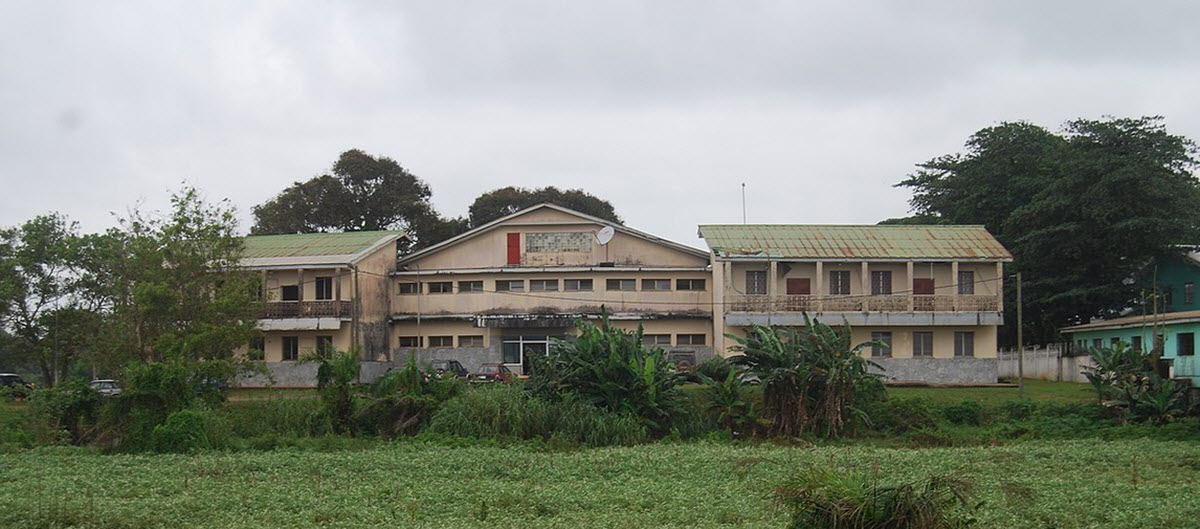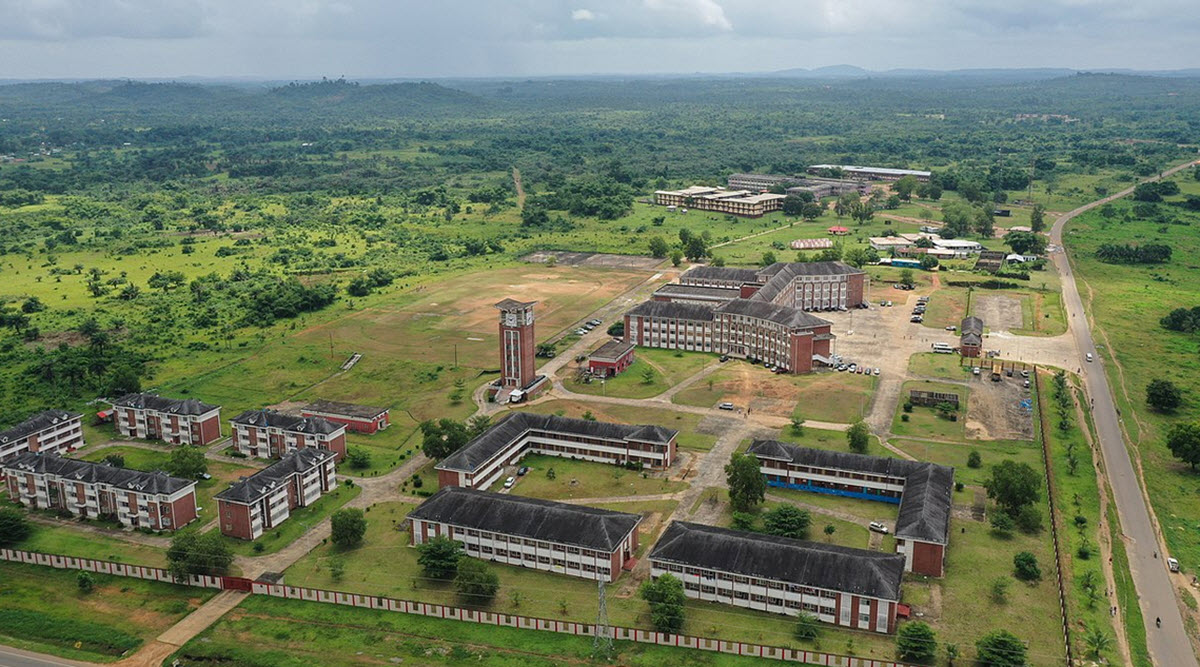The University of Liberia is a publicly funded institution of higher learning in Liberia and it enrols around 18,000 students, making it the largest university in Liberia by enrolment. Data from 2019 shows 12,278 male and 6,422 female students enrolled at the university. For the same year, the university had 331 faculty members, of which 27 were women.
Headquartered in Monrovia, the University of Liberia has four campuses:
- Capitol Hill Campus in downtown Monrovia. This is the main campus.
- Fendall Campus in Louisiana (circa 23 km from Monrovia). The College of Agriculture and Forestry is at the rural Fendell Campus.
- The Medical School Campus in Congo Town
- The Straz-Sinje Campus in Sinje, Grand Cape Mount County
The roots of this institution go back to 1862 when Liberia College was established.
The University of Liberia is the oldest degree-grating school in West Africa, and one of the oldest extant institutions of higher learning in the region. It is accredited by the Liberian Commission on Higher Education and is a member of the Association of African Universities.

Academics
The school contains:
- 6 colleges
- 3 professional schools
- 3 graduate programs
- 5 institutes
Colleges at the University of Liberia
- The Liberia College of Social Sciences and Humanities
- The College of Business and Public Administration
- The College of General Studies
- The T. J. R. Faulkner College of Science and Technology
- The William V. S. Tubman Teachers College
- The William R. Tolbert College of Agriculture and Forestry
Professional schools
- Louis Arthur Grimes School of Law.
This is the only law school in Liberia, and it was established in 1951.
- The A. M. Dogliotti College of Medicine
This professional school was opened as a partnership between the Liberian government and the Italian-based A.M. Dogliotto Foundation. After graduation, each student must work one year in rural areas.
- The School of Pharmacy
Graduate programs
- The Ibrahim B. Babangida Graduate Program in International Relations
- The Graduate Program in Regional Science
- The Graduate Program in Education Administration
Institutes
- The Institute for Research
- The Institute for Population Studies
- The Kofi A. Annan Center for Conflict Transformation
- The Center for Millennium Development Goals
- The Confucius Institute (in cooperation with the Changsha University of Science and Technology in China)
Short facts about the University of Liberia
Language
Classes are taught in English
Academic year
The academic year runs from September through August.
Degrees
- Undergraduate students earn 4-year bachelor´s degrees.
- The graduate programs offer master´s degrees after 2-years of post-graduate work.
- Doctorates in medicine are conferred after the completion of a 7-year program.
Abbreviation
University of Liberia is abbreviated UL. In older texts, the abbreviation LU is used.
Motto
Lux in tenebris
(Light in darkness)
University colours
Red, white and blue
Trivia
In the 1800s, freshmen and sophomores would battle each other in an annual ritual over whether the freshmen would be allowed to wear trousers.

University of Liberia in the 21st century
The University of Liberia suffered greatly during the civil strife and widespread political violence that marked the four last decades of the 20th century in Libera. After the end of the Second Liberian Civil War in 2003 and the completion of the 2005 Liberian general election, the American Bar Association paid for renovations of the damaged and run-down law school in 2007. That same year, a private company paid for the creation of a 200-computer digital centre at the university, and in 2008 China funded a 21.5 million USD expansion of the Fendall Campus. In 2009, construction began for the new Angie Brooks International Center for Women´s Reseach, Peace and Security at Fendall Campus, and the Harvey S. Firestone Quadrangle Science Building at the main campus was renovated by Firestone Liberia.
In March 2009, enrollment at the University of Liberia reached 18,000.
History
Background
- Liberia declared independence from the American Colonization Society in 1847.
- In 1851, the new national legislature authorized the creation of a state college and chartered Liberia College.
- Money for the college was provided by two United States-based organisations: the New York Colonization Society and the Trustees of Donations for Education in Liberia. Throughout the 1800s, these two organisations would continue to provide most of the funds for the school and be responsible for hiring the faculty.
- Before there was a college in Liberia, some Liberians were getting their higher education in Great Britian, and there was some worry among the U.S. backers that this would cause influential members of Liberian society to move away from the republican form of government.
- Colleges and individuals in the United States donated bricks and lumber to construct a school building for Liberia College.
- Rivalry between several Liberian cities delayed the actual creation of the Liberia College, but on 25 January, 1858, the cornerstone of the first college building was finally laid in Monrovia, the capital city.
Early years
- Liberia College was inaugurated in January 1862 and classes commenced in 1863.
- Books were donated by colleges and individuals in the United States, and when the Liberia College library opened it held around 4,000 volumes.
- The first class of students was comprised of seven men. Two months later, a college preparatory division was added, in which 18 students were enrolled.
- The curriculum was comprised of the standard courses normally thought at colleges in the United States, such as Latin and rhetoric.
- The first president of Liberia College was Joseph Jenkins Roberts, who had been Liberia´s first president after independence (in office 1848-1856) and would become its seventh president as well (in office 1872-1876). Roberts was college president from 1862 to 1876, the year of his death.
- Under the influence of school president Edward Wilmot Blyden, who held that position in 1881-1884, women were permitted to enroll in the preparatory department at Liberia College.
- Liberia College was temporarily closed several times in the 1890s because of class and caste conflicts in Liberia and within the college.
- From 1866 to 1902, the school had only 10 graduates.
The school grows
- A School of Forestry was established at Liberia College in 1942.
- By 1948, enrollement at Liberia College had grown to circa 70 students. Two years later, that number was 100.
Becomming a university
- Liberia College was transformed into the University of Liberia in 1951. Two driving forces behind the change were school president J. Max Bond, Sr. and dean Anna E. Cooper.
- That same year, a Law School was established at the university and named after former Liberia Supreme Court Chief Justice Louis Arthur Grimes.
- By 1956, the number of enrolled students had grown to 259.
- A medical school was added in 1968.
Civil strife
From the 1970s, civil strife i Liberia caused the university to close down on several occasions, including in 1979, 1984 and 1990.
In August 1984, Liberian President Samuel K. Doe sent the army to attack the university, as students and faculty were protesting the arrest of two faculty members. The attack resulted in several deaths, over 100 people were injured and some of the university facilities were destroyed.
Due to the First Liberian Civil War (1989-1997), no degrees were granted in 1989-1996.
Re-opening
University of Liberia re-opened in 1997 and enrolled 6,000 students. Many previous faculty members were no longer in the country as they had fled from the war.
The Second Liberian Civil War started in 1999 and ended in 2003.